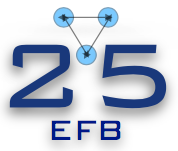Speaker
Description
The p-p-p correlation function is defined as
$$C_{123} (Q) = \int \rho^5 d\rho\,d\Omega\, S_{123}|\Psi_s|^2$$ where $\rho,\Omega$ are the hyperspherical coordinates and $\hbar^2Q^2/M$ is the total energy of the system. The source is represented by a gaussian hypercentral profile $$S_{123}=\frac{1}{\pi^3\rho_0^6}e^{-\rho^2/\rho_0^2}$$ The three-proton wave function, $\Psi_s$, is calculated using the hyperspherical adiabatic basis $$ \Psi_s=\frac{1}{(Q\rho)^{5/2}}\sum_{J^\pi, K} \sum_\nu u^K_\nu(\rho) \phi^{J^\pi}_\nu(\rho,\Omega)$$ where $\phi_\nu^{J\pi}$ are the adiabatic basis elements having total angular and parity $J^\pi$, $K$ is the grand angular quantum number labeling the regular channel in the asymptotic behavior of the hyperradial functions $u^K_\nu$.
The finite range character of the source allows to use the free scattering wave function in the description of the three protons in most of the adiabatic channels except the lowest ones. Moreover, the proper antisymmetrization of the state has been performed considering the different possible combinations of symmetries in the spatial and spin parts of the wave function. In this preliminary study, the interaction between nucleons is modeled using a two-body Gaussian potential with parameters, range and strength, fixed to reproduce the pp scattering length and effective range. Moreover, the Coulomb interaction has been considered in its hypercentral form.
The correlation function can be measured using femtoscopy techniques at LHC by the ALICE collaboration. The obtained results are compared to the available data and have to be considered as a preliminary step in the complete treatment of the nuclear interaction and the asymptotic p-p-p scattering wave function.

